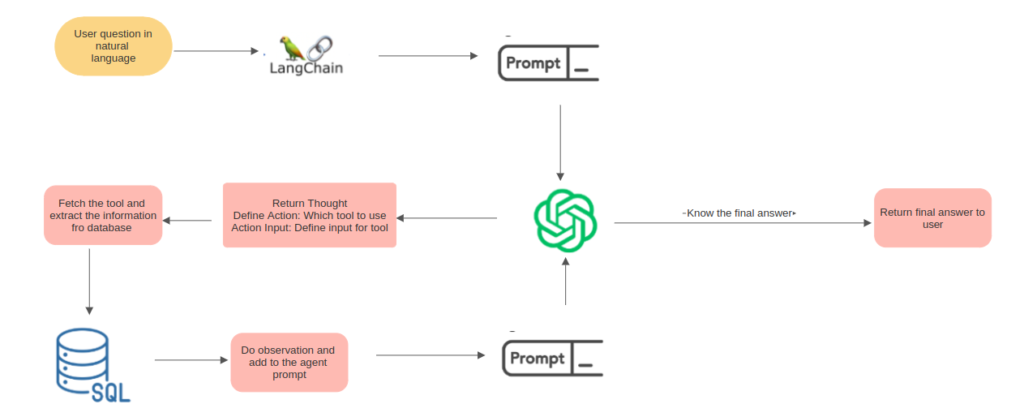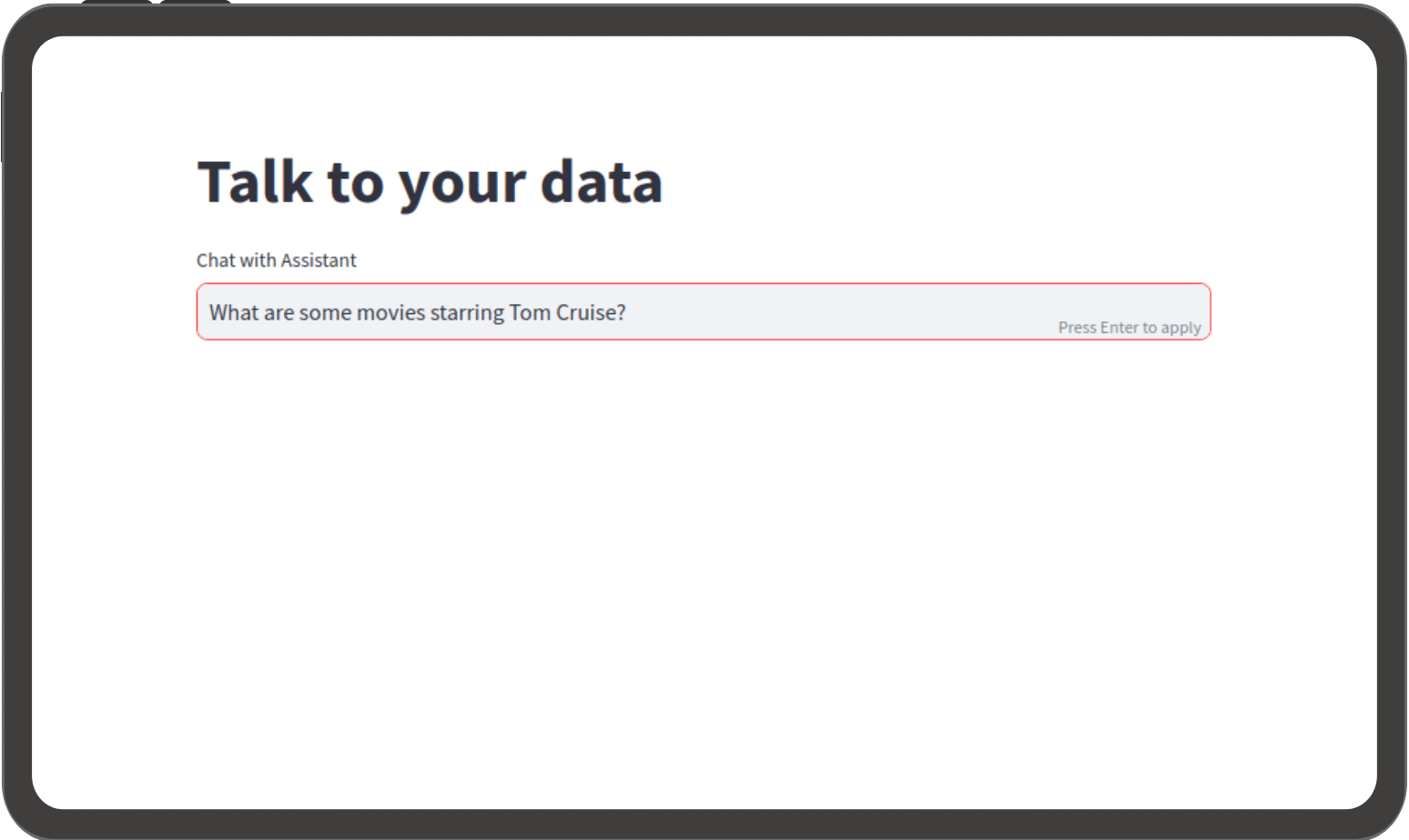How to Unlock GenAI & Turn Structured Data into Conversation

Introduction
Welcome to our latest blog post! Meet MadgicalTechdom, an India-based company providing AI-powered customer engagement solutions. Our platforms, driven by smart technology, facilitate seamless communication between businesses and customers via chat, voice, and email. We cater to diverse industries like online shopping, finance, and healthcare, offering support for various queries including order tracking and refunds.
Discussing the challenges faced by a chatbot development company serving a massive user base of 200 million worldwide. Tasked with creating a chatbot for a political figure, their goal is to address followers’ inquiries about socio-economic contributions. Managing extensive data stored in Excel sheets, including thousands of records related to government projects and schemes, the company faces the challenge of extracting relevant information and crafting natural responses. To overcome this obstacle, We suggested for Generative AI. Integration of Generative AI significantly enhances the chatbot’s performance, leading to heightened user satisfaction.
Learn how Gen AI transformed data challenges into seamless user experiences for this chatbot company. Explore the GitHub link to install and try it yourself, or reach out if your company needs any assistance.
Business Challenges with Structured Data

In our blog, we’ll delve into the challenges encountered while working with structured and unstructured data. These challenges include:
- Complexity in Query Writing: Users can ask various types of questions, making it impractical to pre-build all possible query combinations with structured data. This complexity adds difficulty to the task of writing effective database queries.
- Data Synthesis: With structured data, information may exist in diverse formats and locations, making it challenging to consolidate and summarize in advance for all potential user inquiries. This diversity complicates the process of synthesizing information for effective responses.
- Time-Consuming Manual Effort: Manually summarizing structured data from different perspectives is labor-intensive and cannot cover all potential use cases comprehensively. This manual effort consumes significant time and resources without guaranteeing comprehensive coverage.
- Generating Personalized Answers: With structured data, users may phrase their queries in various forms, making it difficult to provide personalized responses tailored to each user’s specific context. This challenge adds complexity to generating responses that effectively address user inquiries.
Gen AI: Overview and Its Capabilities
Gen AI, a robust artificial intelligence platform, offers tools and models for tackling complex problems, including data analysis. Leveraging advanced machine learning techniques like natural language processing (NLP), it comprehends and generates text akin to human writing. Trained on extensive datasets, Gen AI ensures high accuracy in text analysis and generation. Beyond text, it excels in language translation, sentiment analysis, summarization, and more. This technology revolutionizes the study of structured and unstructured celebrity data, automating and enhancing the process significantly.
Enhancing Structured Data Analysis with Gen AI
Gen AI models streamline the conversion of natural language sentences into SQL queries, facilitating data analysis. This process simplifies the translation of human language into actionable commands for structured data. It generates SQL queries from posed questions and retrieves results from tables, presenting them in understandable natural language. This functionality benefits business analysts, data scientists, and non-technical users by providing access to database data without requiring SQL expertise.
How Our Solution Works with GenAI

- User question in natural language: This is where the user asks a question or provides a query in a way that is understandable to humans, without any specific formatting or instructions for the system.
- Instruction with user question: Upon receiving the user’s query, an instruction or prompt is initiated using the langchain framework for the SQL agent. This prompt sets the stage for the subsequent steps in formulating a response.
- Define Action and Input: The system assesses the user’s query to select the best tool or method based on factors like requested information and tool capabilities. Once chosen, the system specifies necessary input data, such as table names and extraction criteria for database operations.
- Extracting Data from a Database: The system uses defined input to extract relevant data, employing the chosen tool. This may involve SQL queries for structured data or alternative methods for unstructured data. Additionally, if needed, the system may utilize database queries for precise data retrieval based on user-specified criteria.
- Do observation and add to the agent prompt: After extracting information from the database, the system analyzes the retrieved data along with any additional context from the user’s query. These insights refine the response, ensuring it effectively addresses the user’s query.
- Return Thought: Once the information is gathered and observed, the system crafts a clear response based on the data. This response is structured as a narrative or “thought” to answer the user’s query effectively.
- Return a final answer to the user: The refined response is then presented clearly and informatively to the user. It’s designed to be easily understandable, ensuring the user receives a satisfactory answer to their original query.
Tackling Structured Data Challenges for User Queries
1. Extracting Data for User Questions
When developing a chatbot for structured and unstructured data, we face the challenge of users communicating in natural language rather than database queries. To bridge this gap, we must extract relevant information from structured data by understanding and translating user queries into database queries. For example, if a user asks, “What projects done in XYZ District?”, the chatbot must interpret this and generate a query to fetch the relevant project data from the database. This process requires natural language understanding and query generation capabilities within the chatbot. Despite the complexity in query writing, once the query is created, it’s executed on the database to retrieve the information, enabling smooth interaction via the chatbot.
2. Executing Generated Queries on the Database
After generating queries from user questions for our celebrity database chatbot, the next crucial step is execution, which involves data retrival. However, before executing queries, understanding the database schema is paramount. The schema defines the structure of the tables, including the attributes and their relationships, which is essential for data analysis. Without this knowledge, generating accurate queries becomes challenging, and executing them may lead to errors or incorrect results. Thus, familiarizing ourselves with the schema ensures the queries align with the database structure, facilitating accurate data retrieval and data analysis. Once we understand this, we can confidently run the queries to get the information from the database. Then, we can give helpful answers to users using the chatbot.
3. Interpreting Data Output for Effective Communication
In the process of developing a chatbot for our celebrity database, after extracting information using generated queries, we encounter the critical task of understanding the data output, which involves data analysis. Sometimes, retrieved data may not directly answer user queries due to inaccuracies in the query or irrelevant information. In such cases, careful analysis of the response is necessary. We refine the query based on the analysis and again retrieve relevant data. Once we obtain the correct information, the final step is to communicate it to users in natural language. This ensures that the response is easily understandable and aligns with the user’s query, enhancing the overall user experience with the chatbot interface.
4. Choosing the Optimal Gen AI Model
With numerous text generation models available in the market, including llama and mistral variants, as well as OpenAI’s offerings like GPT-3.5-turbo and GPT-4, selecting the best fit is crucial. We experimented with llama and mistral but found limitations due to their training datasets, hindering accurate query generation. Turning to OpenAI’s models, GPT-3.5 -turbo proved effective in generating database queries from user questions, albeit occasional failures. However, GPT-4 demonstrated superior performance, albeit at a higher cost compared to GPT-3.5. Ultimately, the choice depends on the balance between accuracy and affordability, with GPT-4 offering exceptional query generation capabilities but at a premium price.
5. Time Reduction in Querying using Gen AI
Our bot drastically minimizes time spent on query processing compared to manual methods. When a user submits a query, the bot swiftly analyzes it, retrieves relevant data from the database, and delivers a response within minutes. In contrast, manual querying involves several time-consuming steps. First, analysts must interpret the user’s query, then assess its alignment with the database schema. Next, they construct a query, execute it, and finally formulate a response for the user. This manual process is laborious and time-intensive. By leveraging our bot’s automated capabilities, users receive prompt and efficient responses, streamlining the entire query-handling process.
6. Enhancing User Satisfaction through Cost Optimization and Caching
To ensure user satisfaction, we implement cost optimization strategies such as caching. With each model call in response generation, there’s a associated cost and time overhead. By caching previously processed queries and their corresponding responses, we avoid redundant calls for identical queries. When a user repeats a question, instead of recalculating the response, we retrieve it from the cache, reducing both time and cost. This optimization not only enhances user experience by providing quicker responses but also minimizes resource utilization, ultimately improving overall system efficiency and user satisfaction.
7. Retrieving Data from Caching: Leveraging Cosine Similarity
To efficiently retrieve data from caching, we employ cosine similarity, a metric for measuring the similarity between two texts. Each question and its corresponding answer are represented as vectors, which capture their semantic meaning. These vectors are stored in a vector database. When a user poses a question, we generate its vector using embedding models like OpenAI’s, then search the vector database for similar questions using techniques like nearest neighbor search. Various vector databases, such as Milvus, Pinecone, and Weaviate, offer different features and trade-offs. By leveraging cosine similarity and vector databases, we can quickly identify and retrieve responses to similar questions, enhancing user experience and system efficiency.
The Consequences of Not Implementing This Solution
In considering the ramifications of not implementing the solution at hand, it becomes apparent that several challenges may arise:
- Time Consumption: Without leveraging this solution, tasks related to database management can become up to 40% more time-consuming, leading to delays in data retrieval and analysis.
- Increased Effort in SQL Query Writing: The absence of this solution necessitates up to 35% more extensive thought and effort in crafting SQL queries to extract desired data from the database. This increased complexity can lead to inefficiencies and errors in query formulation.
The Benefits of Implementing This Solution
After adopting this solution, the advantages become evident:
- Saving Development Time: By streamlining the process of querying databases, this solution reduces development time by up to 50%, enabling teams to achieve tasks more efficiently and increase productivity.
- Resource Savings: Previously, multiple team members may have been needed to write complex SQL queries, resulting in increased resource allocation. With this tool, resource requirements are reduced by approximately 30%, as it empowers individuals to efficiently retrieve data without extensive SQL knowledge.”
- Human Language Understanding: This solution’s capability to comprehend human asked queries, simplifies the interaction with databases, enabling users to express their data retrieval needs in a more intuitive manner.
- Handling Interconnected Tables: With the ability to work seamlessly across multiple interconnected tables within a database, this solution enhances data accessibility and facilitates comprehensive analysis across various datasets.
Limitations to Consider
While this solution offers significant advantages, it’s essential to acknowledge its limitations:
- Response Generation Time: One drawback is the time it takes to generate responses. Depending on the complexity of the query and the workload on the system, users may experience delays in receiving responses, impacting overall workflow efficiency.
- Cost Considerations: Utilizing this solution from OpenAI may incur costs, especially for organizations with high query volumes or complex data needs. It’s essential to factor in these costs when evaluating the feasibility of implementation.
Conclusion

In our blog, we’ve learned about the struggles of a chatbot company trying to create a celebrity chatbot using structured data. They faced a big problem: lots of new questions from users every few days, which meant they had to spend a lot of time for data analysis and coming up with answers.
But then they discovered Gen AI, a really smart tool that helped them with all their data stuff. When they started using Gen AI, something amazing happened: their chatbot got a lot better, and users were much happier.
So, what did we learn? We learned that with the right tools, like OpenAI, even tough challenges can be overcome. By using OpenAI, the chatbot company was able to save time and make their chatbot work better. Plus, they were able to reduce costs by 75%, since they no longer needed one person to analyze queries and create answers – OpenAI did it for them, and at a lower cost too!
So, If you’re facing the same issues and need our help, don’t hesitate to contact us for a free consultation.
Further Reading
- Langchain SQL Agent
- Transforming Education: How GenAI Video Search Drove Ed Tech Growth
- 30% Time Savings in AI Development: The EKS CI/CD Solution
- How to Achieve 60% AWS Cost Optimization with Functions and Tags
- Why You Can’t Focus 100% of the Time
Follow Us
Madgical@LinkedIn
Madgical@Youtube
Disclaimer
*The views are of the author and not necessarily endorsed by Madgical Techdom.